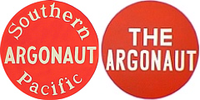
Argonaut (passenger train)
Encyclopedia

Southern Pacific Railroad
The Southern Pacific Transportation Company , earlier Southern Pacific Railroad and Southern Pacific Company, and usually simply called the Southern Pacific or Espee, was an American railroad....
secondary transcontinental
Transcontinental railroad
A transcontinental railroad is a contiguous network of railroad trackage that crosses a continental land mass with terminals at different oceans or continental borders. Such networks can be via the tracks of either a single railroad, or over those owned or controlled by multiple railway companies...
passenger train, inaugurated in 1926, and operated between New Orleans and Los Angeles
Los Ángeles
Los Ángeles is the capital of the province of Biobío, in the commune of the same name, in Region VIII , in the center-south of Chile. It is located between the Laja and Biobío rivers. The population is 123,445 inhabitants...
via Houston, San Antonio, and El Paso, Texas; Demming, New Mexico; Douglas and Tucson, Arizona; and Palm Springs, California, until its discontinuance in 1961. In addition to passenger cars from New Orleans to the west coast, it also carried sleeping cars from New Orleans to San Diego via the San Diego & Arizona Eastern, a SP subsidiary. Westbound trains carried sleeping cars from both New Orleans and Houston to San Antonio.
While the Sunset Limited
Sunset Limited
The Sunset Limited is a passenger train that for most of its history has run between New Orleans, Louisiana and Los Angeles, California, and that from early 1993 through late August 2005 also ran east of New Orleans to Jacksonville, Florida, making it during that time the only true transcontinental...
was the premiere SP train on the "Sunset Route" — and probably on the whole SP system — the Argonaut was always a secondary train, running on a slower timetable than the Sunset Limited. The Argonaut needed fifty hours between New Orleans and Los Angeles, while the Sunset Limited needed only forty-two. Unlike the Sunset Limited, which was made for first-class luxury passenger travel, the Argonaut was always a train for economy travel, carrying mostly standard coaches and few standard sleepers, allowing normal people to enjoy transcontinental rail travel at moderate prices but with full dining
Dining car
A dining car or restaurant carriage , also diner, is a railroad passenger car that serves meals in the manner of a full-service, sit-down restaurant....
and sleeping car
Sleeping car
The sleeping car or sleeper is a railway/railroad passenger car that can accommodate all its passengers in beds of one kind or another, primarily for the purpose of making nighttime travel more restful. The first such cars saw sporadic use on American railroads in the 1830s and could be configured...
service.
Throughout its entire life the train comprised olive green and black heavyweight passenger cars, pulled by steam locomotives like the GS-1 4-8-4
4-8-4
Under the Whyte notation classification of steam locomotives, 4-8-4 represents the wheel arrangement of four leading wheels on two axles , eight powered and coupled driving wheels on four axles, and four trailing wheels on two axles .Other equivalent classifications are:UIC classification: 2D2...
or MT-4 4-8-2
4-8-2
Under the Whyte notation for the classification of steam locomotives, 4-8-2 represents the wheel arrangement of four leading wheels on two axles , eight powered and coupled driving wheels on four axles, and two trailing wheels on one axle...
, sometimes even a Cab Forward 4-8-8-2
4-8-8-2
Under the Whyte notation for the classification of steam locomotives, a 4-8-8-2 is a locomotive with four leading wheels, two sets of eight driving wheels, and a two-wheel trailing truck.Other equivalent classifications are:...
. In its last years, the train was pulled by EMD F7
EMD F7
The EMD F7 was a Diesel-electric locomotive produced between February 1949 and December 1953 by the Electro-Motive Division of General Motors and General Motors Diesel . It succeeded the F3 model in GM-EMD's F-unit sequence, and was replaced in turn by the F9. Final assembly was at GM-EMD's La...
or ALCO PA/PB
ALCO PA
ALCO PA refers to a family of A1A-A1A diesel locomotives built to haul passenger trains that were built in Schenectady, New York in the United States by a partnership of the American Locomotive Company and General Electric between June, 1946 and December, 1953...
diesel locomotives.
Additional material from Night Trains, Johns Hopkins University Press, 1989.

